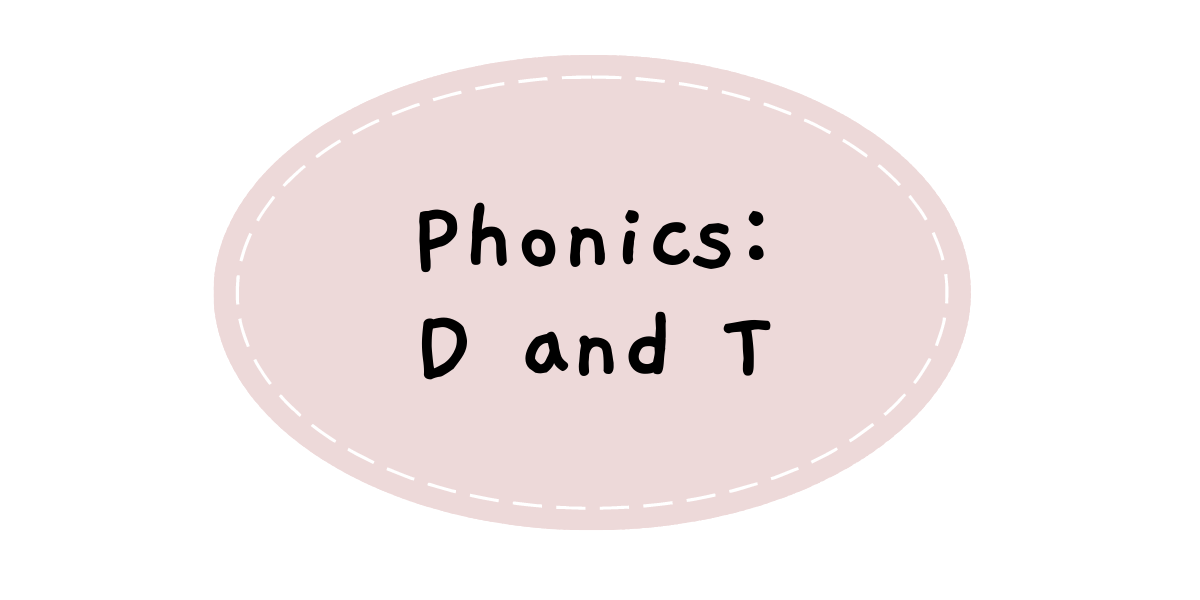Vowels and Consonants: D and T
Vowels and Consonants: D and T
The letters “D” and “T” will be the next letters that we look at in our phonics lesson. I would recommend that, if you are teaching your child English pronunciation from scratch, you should start with our first two phonics lessons on vowels and the consonant pair /b/ and /p/.
Like /b/ and /p/, /d/ and /t/ are a voiced/unvoiced consonant pair. As well, all four of these letters are Stop Consonants, consonants that completely stop the airflow before having it burst out.
If you need any more help with vowels and consonants, check out our Vowels and Consonants Resources Page for lessons, flashcards, and articles.
Alveolar Consonants
Unlike /b/ and /p/, /d/ and /t/ are “Alveolar Consonants“. An Alveolar Consonant is formed when your tongue touches or comes close to the hard ridge behind your upper teeth. If you are having difficulties finding that, take a look at our mouth diagram.
How to Pronounce D
To form the /d/ sound, start with your mouth slightly open and teeth together. The tip of your tongue should be on the hard ridge behind your upper teeth. Your tongue should block all airflow through your mouth. When you start, you should feel a bit of pressure from the air being held back. You will then release this pressure by bringing your tongue down to make the /d/ sound. Do not forget that /d/ is a voiced consonant, so the sound should also be coming from your vocal cords, and you should be able to feel their vibration.
Teacher’s Tip: The /d/ sound is short and clipped. It should not extend into a “duh” sound. Try to avoid these added vowel sounds on the end of consonants to improve your child’s English pronunciation.
The IPA symbol for /d/ is d.
Common words with /d/:
- Dad
- Dog
- Doctor
- Desk
- Dinosaur
How to Pronounce T
The /t/ sound is pronounced very similarly to the /d/ sound that we have already learned. /d/ is the voiced version of /t/, so the mouth position will be the same. The difference will be where the sound is coming from. /d/ comes from your vocal cords, while /t/ is made solely through air puffing out of your mouth. /t/ is a short, sharp sound, do not extend it with vowel sounds to make it “tuh”. Remember that your tongue will start on the ridge behind your upper teeth. this will cause the airflow to stop, and then release it in a burst of air.
The IPA symbol for /t/ is t.
Common words with /t/:
- Tea
- Turtle
- Hot
- Talk
- Top
Other Vowel and Consonant Lessons That You Might Like
How to Teach Your Vowels and Consonants
- Print out our flashcards or make your own. You want to make sure the flashcard has the letter on one side and a picture on the other for your child to associate with the sound.
- Teach the name of the letter and the sound that that letter makes to your child. If you do not feel confident in making the sound correctly yourself, you can use the videos we have provided in our Member’s Section.
- Teach your child the word that is associated with this letter ( A is for apple, /a/ /a/ apple). If possible, have them draw the word it is associated with.
- If your child is old enough, teach them how to write the letter (both the small and big version). Make sure to emphasize the name and the sound that the letter makes while your child is writing.
- Verify with a teacher or native English speaker that your child is making the sound correctly
After Your Child Has Learned This Sound
Once you know your child is making the sounds correctly, you should look to practice phonics as much as possible. Basic phonics are incredibly important, and getting this right now will help your child in the future. Remember that the more one-on-one practice time you can give your children, the better they will be in their English pronunciation. It also does not need to be textbooks and flashcards memorization, here is a list of fun activities you can do to practice with your children. No one knows your child better than you, make English time more fun by pairing it with activities they like to do. Anything from coloring, reading, or more active games will be helpful if they are practicing and thinking about the sounds and letters.
Practicing should continue for a while, but when you want to teach something new, you can begin to look at a different phonics lesson. Links for all of these can be found above. As well, you can check their progress on their English pronunciation with some of our assessment quizzes in our Member’s Section.
I Have More Questions
If you have any more questions about this phonics lesson, practicing these sounds, or where to go from here, we have a couple of resources for you here at The Learner’s Nook.
- Here is a glossary of terms we use in these guides which may help clear up some confusion.
- Here is a diagram of a mouth with labels if you do not understand which part of the mouth should be moving.
- Here you can see a general overview of how to teach phonics to your ESL children which may be what you are looking for.
